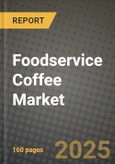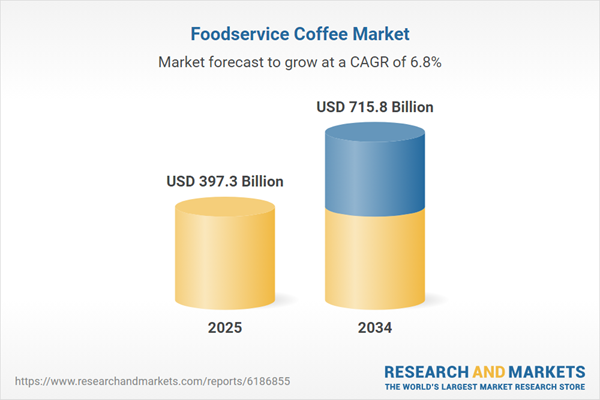Foodservice Coffee Market Overview
The Foodservice Coffee Market is witnessing strong growth as coffee culture continues to expand globally, driven by evolving consumer preferences, rising disposable incomes, and increasing demand for premium and specialty coffee. Coffee has become an integral part of social and workplace routines, fueling demand across cafés, restaurants, hotels, and corporate spaces. The rise of third-wave coffee culture has elevated consumer expectations, emphasizing quality, sustainability, and ethical sourcing. Coffee chains and independent specialty coffee shops are thriving as they cater to diverse preferences, offering single-origin beans, organic blends, and innovative brewing techniques. Meanwhile, convenience-driven formats such as ready-to-drink (RTD) coffee and self-service coffee stations in quick-service restaurants (QSRs) are reshaping the industry. Digitalization and mobile ordering are also playing a key role in enhancing customer experiences, with loyalty programs and personalized recommendations driving sales growth. The market is set to continue expanding as industry players innovate with new flavors, brewing methods, and sustainable packaging solutions.The Foodservice Coffee Market has experienced notable developments, particularly in sustainability, automation, and consumer-driven preferences. Leading coffee chains have expanded their efforts in ethical sourcing, with an emphasis on direct trade partnerships and carbon-neutral operations. Technological advancements, including AI-driven coffee machines and robotic baristas, are revolutionizing efficiency and consistency in coffee preparation. Premiumization remains a key driver, with customers willing to pay more for specialty-grade coffee, cold brews, and nitro-infused beverages. Plant-based milk alternatives, such as oat and almond milk, continue to gain traction, prompting cafés to expand dairy-free options. Meanwhile, demand for convenient coffee formats is growing, with drive-thru and pickup-only coffee outlets emerging in urban centers to meet on-the-go consumption needs. However, supply chain disruptions and fluctuating coffee bean prices remain a challenge, impacting cost structures for foodservice operators worldwide.
The Foodservice Coffee Market is expected to witness continued expansion, with a greater focus on sustainability, innovation, and digital transformation. The rise of climate-conscious consumers will push brands to adopt carbon footprint labeling and expand circular economy initiatives, such as reusable cup programs and compostable packaging. AI and machine learning will further enhance customer engagement, with predictive analytics helping businesses optimize inventory and personalize offerings. The specialty coffee segment will see sustained growth, with more independent roasters and micro-lot offerings gaining popularity. Cold coffee formats, including bottled cold brew and sparkling coffee, will continue to rise in demand. Emerging markets in Asia-Pacific and Latin America will present new growth opportunities, driven by rising urbanization and shifting lifestyles. Meanwhile, automation in coffee preparation will become more sophisticated, allowing foodservice operators to maintain quality while managing labor shortages. As consumer expectations evolve, brands that prioritize ethical sourcing, digital convenience, and unique flavor experiences will maintain a competitive edge in the market.
Key Insights: Foodservice Coffee Market
- Growth of Premium and Specialty Coffee: Consumers are increasingly seeking high-quality, single-origin, and sustainably sourced coffee, driving the expansion of specialty cafés and premium coffee offerings in foodservice establishments.
- Rise of Cold and Ready-to-Drink (RTD) Coffee: The demand for cold brew, nitro coffee, and bottled RTD coffee continues to rise, catering to convenience-driven consumers looking for refreshing alternatives to hot beverages.
- Expansion of Plant-Based Milk Alternatives: With growing demand for dairy-free options, foodservice operators are expanding their offerings to include oat, almond, and soy milk as standard choices for coffee beverages.
- Integration of AI and Automation: Smart coffee machines, robotic baristas, and AI-driven ordering systems are enhancing efficiency, consistency, and personalized customer experiences in foodservice coffee outlets.
- Sustainability and Ethical Sourcing: Coffee brands are emphasizing ethical sourcing, direct trade relationships, carbon-neutral operations, and eco-friendly packaging to align with environmentally conscious consumers.
- Increasing Coffee Consumption in Emerging Markets: Rapid urbanization, rising incomes, and evolving consumer preferences in Asia-Pacific and Latin America are driving the expansion of foodservice coffee businesses in these regions.
- Demand for Convenience and On-the-Go Coffee: Busy lifestyles and the rise of mobile ordering, drive-thrus, and self-service coffee stations are fueling demand for quick and convenient coffee solutions.
- Rising Health and Wellness Trends: Consumers are increasingly opting for organic, low-sugar, and functional coffee beverages infused with adaptogens, collagen, and other wellness-focused ingredients.
- Technological Innovations in Coffee Brewing: Advancements in brewing equipment, AI-powered customer personalization, and automated coffee-making solutions are enhancing the quality and consistency of foodservice coffee offerings.
- Volatile Coffee Bean Prices and Supply Chain Disruptions: Climate change, geopolitical tensions, and logistical challenges are causing fluctuations in coffee bean prices, impacting sourcing strategies and profitability for foodservice coffee providers.
Foodservice Coffee Market Segmentation
By Type
- Take Away Or Delivery
- Dine-in
By Type Of Coffee Bean
- Arabica
- Robusta
- Other Types of Coffee Bean
By Coffee Machine
- Traditional coffee machine
- Automated Coffee Machine
By Food Service Outlet
- Restaurants
- Cafes
- Hotels
- Others Food Service Outlets
Key Companies Analysed
- Nestlé S.A.
- Sysco Corporation
- Starbucks Corporation
- Inspire Brands Inc.
- Kraft Heinz Foods Co.
- Aramark Corporation
- Wawa Inc.
- Ajinomoto Co. Inc.
- J. M. Smucker Company
- Tim Hortons Inc.
- Tchibo Coffee International Ltd.
- Luigi Lavazza S.p.A.
- Melitta Group Management GmbH & Co. KG.
- Tata Consumer Products Ltd.
- Massimo Zanetti Beverage Group S.p.A.
- Peet's Coffee & Tea Inc.
- Costa Limited
- Westrock Coffee Company Inc.
- Illycaffe SpA
- Bewley's Ltd.
- The Coffee Bean & Tea Leaf Philippines Inc.
- Jacobs Douwe Egberts GB Ltd.
- Caffè Nero Group PLC
- Farmer Bros. Co.
- Caribou Coffee Company Inc.
- Juan Valdez Café
- Ediya Co. Ltd.
- Ronnoco Coffee LLC
- Foley Foodservice
- SOHO Coffee Co.
Foodservice Coffee Market Analytics
The report employs rigorous tools, including Porter’s Five Forces, value chain mapping, and scenario-based modeling, to assess supply-demand dynamics. Cross-sector influences from parent, derived, and substitute markets are evaluated to identify risks and opportunities. Trade and pricing analytics provide an up-to-date view of international flows, including leading exporters, importers, and regional price trends.Macroeconomic indicators, policy frameworks such as carbon pricing and energy security strategies, and evolving consumer behavior are considered in forecasting scenarios. Recent deal flows, partnerships, and technology innovations are incorporated to assess their impact on future market performance.
Foodservice Coffee Market Competitive Intelligence
The competitive landscape is mapped through proprietary frameworks, profiling leading companies with details on business models, product portfolios, financial performance, and strategic initiatives. Key developments such as mergers & acquisitions, technology collaborations, investment inflows, and regional expansions are analyzed for their competitive impact. The report also identifies emerging players and innovative startups contributing to market disruption.Regional insights highlight the most promising investment destinations, regulatory landscapes, and evolving partnerships across energy and industrial corridors.
Countries Covered
- North America - Foodservice Coffee market data and outlook to 2034
- United States
- Canada
- Mexico
- Europe - Foodservice Coffee market data and outlook to 2034
- Germany
- United Kingdom
- France
- Italy
- Spain
- BeNeLux
- Russia
- Sweden
- Asia-Pacific - Foodservice Coffee market data and outlook to 2034
- China
- Japan
- India
- South Korea
- Australia
- Indonesia
- Malaysia
- Vietnam
- Middle East and Africa - Foodservice Coffee market data and outlook to 2034
- Saudi Arabia
- South Africa
- Iran
- UAE
- Egypt
- South and Central America - Foodservice Coffee market data and outlook to 2034
- Brazil
- Argentina
- Chile
- Peru
Research Methodology
This study combines primary inputs from industry experts across the Foodservice Coffee value chain with secondary data from associations, government publications, trade databases, and company disclosures. Proprietary modeling techniques, including data triangulation, statistical correlation, and scenario planning, are applied to deliver reliable market sizing and forecasting.Key Questions Addressed
- What is the current and forecast market size of the Foodservice Coffee industry at global, regional, and country levels?
- Which types, applications, and technologies present the highest growth potential?
- How are supply chains adapting to geopolitical and economic shocks?
- What role do policy frameworks, trade flows, and sustainability targets play in shaping demand?
- Who are the leading players, and how are their strategies evolving in the face of global uncertainty?
- Which regional “hotspots” and customer segments will outpace the market, and what go-to-market and partnership models best support entry and expansion?
- Where are the most investable opportunities - across technology roadmaps, sustainability-linked innovation, and M&A - and what is the best segment to invest over the next 3-5 years?
Your Key Takeaways from the Foodservice Coffee Market Report
- Global Foodservice Coffee market size and growth projections (CAGR), 2024-2034
- Impact of Russia-Ukraine, Israel-Palestine, and Hamas conflicts on Foodservice Coffee trade, costs, and supply chains
- Foodservice Coffee market size, share, and outlook across 5 regions and 27 countries, 2023-2034
- Foodservice Coffee market size, CAGR, and market share of key products, applications, and end-user verticals, 2023-2034
- Short- and long-term Foodservice Coffee market trends, drivers, restraints, and opportunities
- Porter’s Five Forces analysis, technological developments, and Foodservice Coffee supply chain analysis
- Foodservice Coffee trade analysis, Foodservice Coffee market price analysis, and Foodservice Coffee supply/demand dynamics
- Profiles of 5 leading companies - overview, key strategies, financials, and products
- Latest Foodservice Coffee market news and developments
Additional Support
With the purchase of this report, you will receive:- An updated PDF report and an MS Excel data workbook containing all market tables and figures for easy analysis.
- 7-day post-sale analyst support for clarifications and in-scope supplementary data, ensuring the deliverable aligns precisely with your requirements.
- Complimentary report update to incorporate the latest available data and the impact of recent market developments.
This product will be delivered within 1-3 business days.
Table of Contents
Companies Mentioned
- Nestlé S.A.
- Sysco Corporation
- Starbucks Corporation
- Inspire Brands Inc.
- Kraft Heinz Foods Co.
- Aramark Corporation
- Wawa Inc.
- Ajinomoto Co. Inc.
- J. M. Smucker Company
- Tim Hortons Inc.
- Tchibo Coffee International Ltd.
- Luigi Lavazza S.p.A.
- Melitta Group Management GmbH & Co. KG.
- Tata Consumer Products Ltd.
- Massimo Zanetti Beverage Group S.p.A.
- Peet's Coffee & Tea Inc.
- Costa Limited
- Westrock Coffee Company Inc.
- Illycaffe SpA
- Bewley's Ltd.
- The Coffee Bean & Tea Leaf Philippines Inc.
- Jacobs Douwe Egberts GB Ltd.
- Caffè Nero Group PLC
- Farmer Bros. Co.
- Caribou Coffee Company Inc.
- Juan Valdez Café
- Ediya Co. Ltd.
- Ronnoco Coffee LLC
- Foley Foodservice
- SOHO Coffee Co.
Table Information
| Report Attribute | Details |
|---|---|
| No. of Pages | 160 |
| Published | October 2025 |
| Forecast Period | 2025 - 2034 |
| Estimated Market Value ( USD | $ 397.3 Billion |
| Forecasted Market Value ( USD | $ 715.8 Billion |
| Compound Annual Growth Rate | 6.7% |
| Regions Covered | Global |
| No. of Companies Mentioned | 30 |









